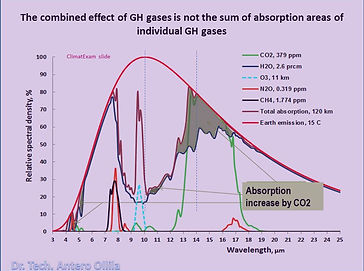Positive water feedback not found in the Mt. Pinatubo eruption

Water vapor feedback has remained a topic of debate since 1990. The laymen do not know that water has an essential role in calculating the warming effects of GH gases. In all Anthropogenic Global Warming (AGW) models the Relative Humidity (RH) stays constant. It sounds like a very neutral and harmless assumption. When GH gases increase the atmospheric temperature, the constant RH means that the absolute amount of atmospheric water also increases. Because water is about a 15 times stronger GH gas than carbon dioxide, this small increase of water content increases the temperature as much as GH gases. According to IPCC, the radiative forcing of GH gases is doubled by water (AR3 and AR4). IPCC calls this feature a positive feedback of water.
According to my spectral analysis calculations, the positive water feedback effect would be this magnitude. But in AR5 (20139 IPCC reports in Science Basis , p. 666: “The contribution of water vapor to the natural greenhouse effect relative to that of carbon dioxide (CO2) depends on the accounting method, but can be considered to be approximately two to three times greater.” There are no references to any scientific publications. This raises a question, if IPCC really knows how to calculate the effects of positive water feedback. The knowledge of water feedback in not getting more accurate but more inaccurate according to IPCC. It is a little bit of strange development after all the money used for climate change research.
The opponents of AGW theory have pointed out the RH measurements do not show constant RH trends as we can see in figure 1, (NOAA, http://www.esrl.noaa.gov/gmd/aggi/)

Figure 1. Relative Humidity (RH) trends from 1948 to 2012
I have called this figure a sight test. If you see that the trends are essentially at the horizontal position and not bending downward, you should test your eyes with the doctor. This is an example but not the only one that IPCC denies the direct measurements, when they do not fit into their theories.
The warming calculations are based on the climate models both in simple as well as in computer based General Circulation Models (GCM). The warming effects of GH gases are very small and there are many other factors. The ongoing pause in the global temperature is a good example of these other factors, which IPCC call natural effects. It is therefore quite difficult to show in the real climate, if there is positive water feedback or not.
Luckily there is one experiment which was organized by the Mother Nature itself. This was the eruption of the Mount Pinatubo. The main eruption began on the island of Luton in the Philippines on the 3rd of June, 1991 and concluded on the next day. Four large explosions generated eruption columns reaching the heights of up to 24 km in the stratosphere. The estimate of the stratospheric mass increase was 14 – 20 Mt of SO2, which created 21-40 Mt of H2SO4–H2O aerosols. The eruption also injected vast quantities of minerals and metals into the troposphere and stratosphere in the form of ash particles. The aerosols created a global layer of sulfuric acid haze over the globe and the global temperatures dropped about 0.5 °C in the years 1991 – 1993. Because of the aerosols and ash particles, the incoming solar radiation decreased 6 W/m2. At the same time there was a maximum increase of downward longwave radiation flux of 4.5 W/m2 caused by the very same aerosols and ash particles. Totally the radiative forcing at the surface was in maximum 1.5 W/m2. This radiation anomaly can be compared to the decrease caused by the doubling of the CO2 concentration from 280 ppm to 560 ppm. According to IPCC data this change is 3.7 W/m2.
I have carried out a dynamic analysis of the temperature effects caused by the eruption. I wanted to test two options for the climate sensitivity parameter (CSP). The radiative forcing (RF) at the top of the atmosphere has a linear relationship to the global mean surface temperature change dT:
dT = CSP*RF (1)
IPCC uses still equation (1) in its latest report AR5 but IPCC no longer keeps the value of CSP as almost constant. There is no information in AR5 as to, what the real value of CSP is or in which way it varies. The CSP value of 0.5 K/(W/m2) has been used in the former reports of IPCC and it includes the positive water feedback. Actually the CSP value of 0.5 still has the decisive role, because IPCC reports in AR5 that the transient climate sensitivity value is likely to lie in the range 1 to 2.5 °C giving the average value 1.75 °C. This value is almost the same as calculated by equation (1): dT = 0.5 K/(Wm-2) * 3.7 Wm-2 = 1.85 K. The value of 0.27 K/(W/m2) has been used showing no water feedback.
I carried out two simulations by a simple dynamic model to test these two CSP values. The results are depicted in figure 2. It is very clear that the CSP value of 0.5 gives results which deviate from the real response of the global temperature decrease.

Figure 2. Simulation of the Mount Pinatubo eruption using different climate sensitivity parameters.
There are two former studies about the dynamic temperature response in the Mt. Pinatubo eruption. Hansen et al. applied GCMs by name SI94 and GRL92 in their simulations published in 1992. Soden et al. also applied a GCM in the research study published in 2002. They also included the absolute atmospheric water content as a variable. The major results were that the GCM simulations could calculate the dT values close to the measured value, if the positive water feedback was included. The water content was calculated using the NASA Water Vapor Project (NVAP) values.
So there are research results which show very different results. What could be the reasons? The reasons are rather simple to point out. All other researchers including me have used maximal solar irradiation decrease value of -6 W/m2 but in these two studies the researchers have used the value -4 W/m2. In the same way other researchers have used the maximal deviation value of -0.5 C during the eruption but in these two studies the value of ~-0.7 C has been used. Soden et al. have included the RH change during the eruption and they have been able to show that there is positive water feedback needed to explain the temperature decrease.

Figure 3. Relative Humidity trends according to NCEP/NCAR Reanalysis and NVAP-M datasets.
In Figure 3 the NVAP dataset values as well the NCEP/NCAR (National Center for Environmental Prediction / National Center for Atmospheric Research) values are depicted. The NVAP water content trends show great seasonal changes of about 3 TPW mm. Soden et al. have reported that there has been ~0.75 TPW mm peak reduction during the Pinatubo eruption. The graphs show that the peak reduction estimate can be regarded a correct estimate. But this choice of using the peak values only can be questioned, because the trend line of NVAP-M values show an increased rate of absolute water content and it is an opposite trend! The figure 3 shows that the RH measurements are not accurate enough to be used as evidence about RH feedback. The average value of these two datasets show practically zero trend during the eruption.
The results of Hansen et al. and Soden et al. can be explained by proper data selection, which is called cherry picking. I have used the most commonly applied data values and the results show no water feedback. This result means that the Climate Sensitivity (CS) is 0.27 K(W7m2) * 3.7 W/m2 = 1 K. Many researchers using different methods have found that the CS would be in the range of 1 to 1.2 C, if the RF value of 3.7 W/m2 of CO2 (increase from 280 ppm to 560 ppm) has been applied. There is only one question remaining, is the RF value of 3.7 W/m2 correct. According to my analysis this value is calculated in the atmosphere, where there is constant RH and therefore positive water feedback. My calculations using three different methods show that the RF value of doubling the CO2 concentration is 2.12 W/m2. Therefore climate sensitivity is only 0.27 * 2.12 = ~0.6 C assuming constant absolute water content in the atmosphere.






















